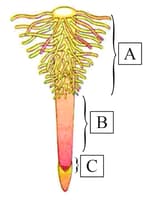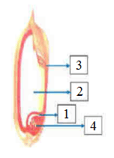Embibe Experts Solutions for Chapter: Morphology of Flowering Plants, Exercise 1: AP EAPCET 2020 (24-Sep Shift-1)
Embibe Experts Biology Solutions for Exercise - Embibe Experts Solutions for Chapter: Morphology of Flowering Plants, Exercise 1: AP EAPCET 2020 (24-Sep Shift-1)
Attempt the practice questions on Chapter 4: Morphology of Flowering Plants, Exercise 1: AP EAPCET 2020 (24-Sep Shift-1) with hints and solutions to strengthen your understanding. EMBIBE CHAPTER WISE PREVIOUS YEAR PAPERS FOR BIOLOGY solutions are prepared by Experienced Embibe Experts.
Questions from Embibe Experts Solutions for Chapter: Morphology of Flowering Plants, Exercise 1: AP EAPCET 2020 (24-Sep Shift-1) with Hints & Solutions
Identify A, B and C in the given diagram of the regions of root tip?

In Alstonia the type of Phyllotaxy is:
Assertion (A): In Nepenthes leaves are modified to trap insects
Reason (R): Insectivorous plants trap insects for their nitrogen requirement
Which of the following is not a stem modification?
Match the following types of placentation with respective plants?
| Column-I | Column-II | ||
| Marginal | Argemone | ||
| Axial | Dianthus | ||
| Parietal | Pea | ||
| Free central | Tomato | ||
| Marigold | |||
(i) When carpels are free, they are called 'A'
(ii) When the carpels fused, they are called 'B'
Here. A and B refers to __________
The side of flower facing the mother axis is called _____
Identify the parts labelled in the figure caryopsis of Oryza?

